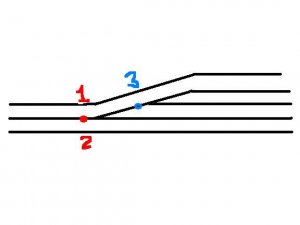My turn-outs are controlled by under-the-layout throw rods. I am going to put Central Valley non-operating switch stands at each turn-out. I will simply add a small piece of cork to the existing roadbed, add some extended ties out onto this, ballast it along with the rest ofthe track, then mount the switch stand on the extended ties.
Question 1: Is there a standard distance from the centerline of the track that switch stands are placed?
Question 2: Say we have a turn-out that is between other tracks, with a clearance from center to center of 14 scale feet. In other words, the turn-out is sandwiched between other tracks. Where would the switch stand go? Would the real railroads use some kind of low-profile stand? Or, is there enough room for a regular switchstand? Or would they use some extra-long throw rod to extend the switch stand outside of the other tracks?
Question 1: Is there a standard distance from the centerline of the track that switch stands are placed?
Question 2: Say we have a turn-out that is between other tracks, with a clearance from center to center of 14 scale feet. In other words, the turn-out is sandwiched between other tracks. Where would the switch stand go? Would the real railroads use some kind of low-profile stand? Or, is there enough room for a regular switchstand? Or would they use some extra-long throw rod to extend the switch stand outside of the other tracks?



